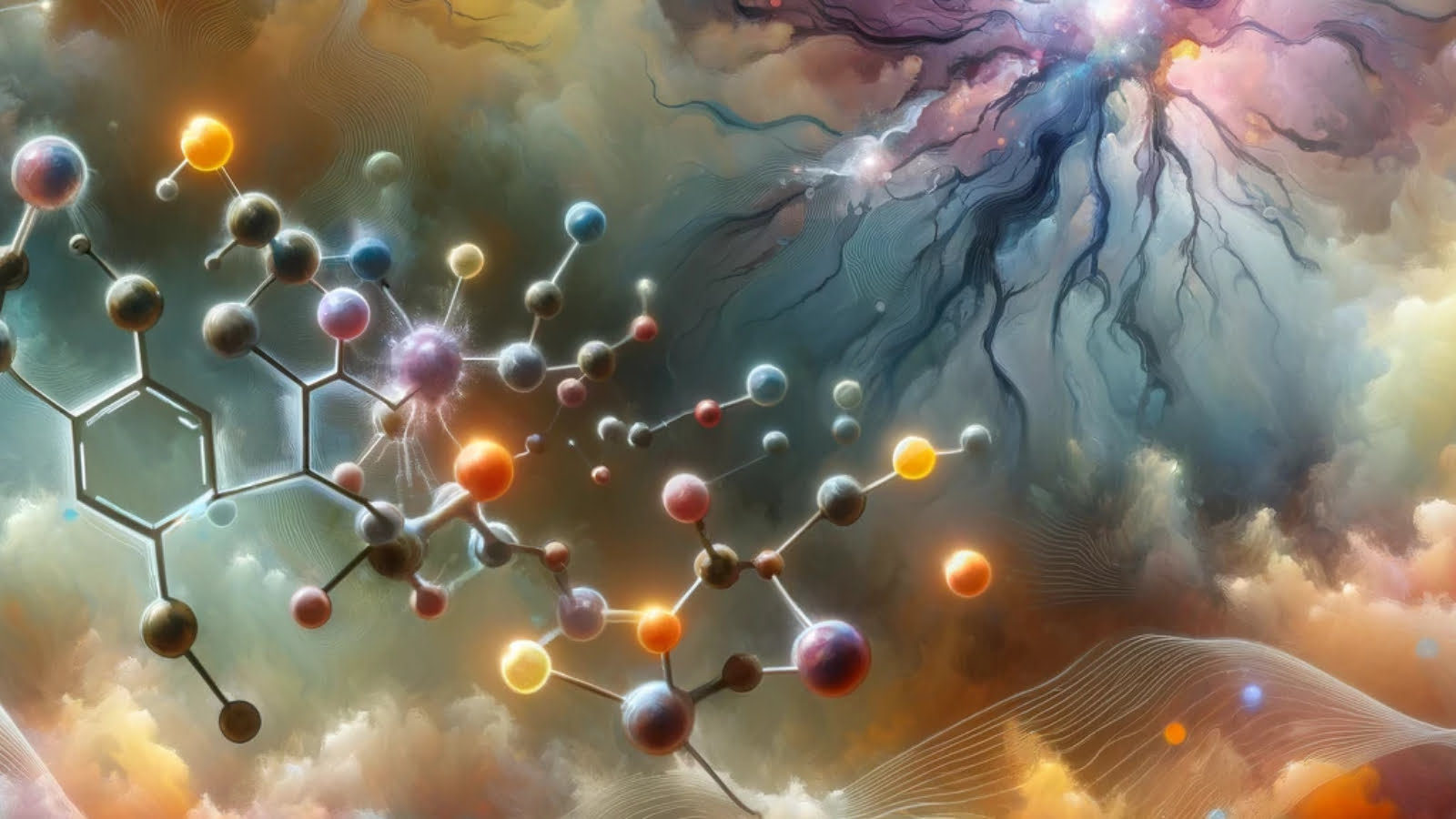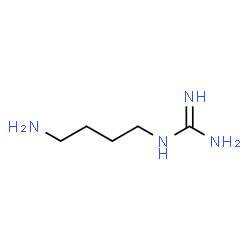
Agmatine functions as a naturally occurring metabolite of the amino acid arginine found in the brain and various tissues throughout the body.
Agmatine operates as both a neurotransmitter and neuromodulator, interacting with multiple receptor systems including imidazoline, α2-adrenergic, and NMDA receptors to influence brain function and mental performance.
Agmatine shows particular promise for athletes seeking performance enhancement, individuals with ADHD requiring improved focus, and people struggling with addiction through its ability to modulate neurotransmitter release, inhibit nitric oxide synthase, and provide neuroprotective properties.
Table of Contents
What is Agmatine and How Does it Relate to Cognitive Enhancement?

Agmantine (also known as decarboxylated arginine, 4-(Aminobutyl)guanidine) is a biogenetic metabolite (bacteria) naturally made from arginine (an amino acid) through a process called decarboxylation.
Agmantine is found in living organisms, including humans, plants, and animals. It was discovered in 1910 by Albrecht Kossel.
This organic compound has been gaining attention in the nootropics community for its potential cognitive-enhancing and neuroprotective properties.
What is the Chemical Structure of Agmatine?
Agmatine’s structure consists of a guanidine group connected to a butyl chain, making it a biogenic amine and a polyamine.
- Molecular formula: C4H14N4
- Molar mass: 130.19 g/mol
- Density: 1.23 g/cm³
- Melting point: 175-177 °C
- Boiling point: 346 °C
- pKa: 9.8
What are the Natural Sources and Biosynthesis of Agmatine?
Agmatine is produced endogenously from arginine by the enzyme arginine decarboxylase (ADC).
It’s widely distributed in mammalian tissues, including the brain, liver, kidneys, and adrenal glands, as well as in various foods and fermented products. Bacteria in the gastrointestinal tract can also synthesize agmatine.
Natural sources of agmatine include fermented foods like beer, wine, and aged cheese, which contain measurable amounts of this compound, along with soy sauce, soybeans, and cereal germs that provide smaller quantities through their spermine content.
What are the Physiological Functions of Agmatine in the Brain and Body?
Agmatine acts as a neurotransmitter and neuromodulator in the central nervous system. It binds to various receptors, including imidazoline, α2-adrenergic, and NMDA receptors, to modulate neurotransmitter release, nitric oxide production, and synaptic plasticity.
Agmatine also regulates polyamine metabolism and has neuroprotective, analgesic, and anticonvulsant properties.
Key roles of agmatine:
- Neurotransmitter and neuromodulator
- Regulates neurotransmitter release
- Inhibits nitric oxide synthase
- Modulates NMDA receptor activity
- Regulates polyamine metabolism
- Neuroprotective, analgesic, and anticonvulsant properties
How Does Agmatine Affect the Brain and Cognitive Function?
Agmatine exerts its effects on the brain through several mechanisms:
- Neurotransmitter modulation
- NMDA receptor modulation
- Nitric oxide synthase inhibition
- Polyamine metabolism regulation
These mechanisms contribute to agmatine’s potential cognitive-enhancing and neuroprotective properties, such as improved memory, learning, attention, and mood, as well as reduced neuronal damage and inflammation.
What are the Mechanisms of Action of Agmatine in the Brain?
Agmatine exerts its effects on brain function through multiple mechanisms:
- Binds to imidazoline receptors: Agmatine is an endogenous ligand for imidazoline receptors, which are involved in regulating neurotransmitter release and blood pressure (including norepinephrine, serotonin, and dopamine, which are involved in attention, mood, and motivation). By binding to these receptors, agmatine can modulate the release of catecholamines like norepinephrine and dopamine, as well as influence insulin secretion and neuroprotection.
- Modulates NMDA receptor activity: The activity of NMDA (N-methyl-D-aspartate) receptors is important for synaptic plasticity, learning, and memory.
- Inhibits nitric oxide synthase production: By inhibiting NOS, agmatine reduces NO levels in the brain, which can have neuroprotective effects and influence neurotransmission, synaptic plasticity, and blood flow regulation.
- Regulates polyamine metabolism: It can inhibit polyamine synthesis by blocking the enzyme ornithine decarboxylase (ODC) and induce polyamine catabolism by activating spermidine/spermine N1-acetyltransferase (SSAT).

What are the Cognitive Benefits of Agmatine?
Agmatine has shown potential cognitive-enhancing effects in preclinical studies. Agmatine benefits people with ADHD by enhancing attention and focus, which improves cognitive performance through optimized neurotransmitter balance and NMDA receptor modulation.
Potential cognitive benefits of agmatine:
- Improved learning and memory
- Enhanced attention and focus
- Neuroprotection and reduced cognitive decline
- Mood-enhancing effects (e.g. reduced anxiety and depression)
- Enhance synaptic plasticity
- Regulates glutamate and NMDA receptor activity
However, more human studies are needed to confirm these cognitive benefits and determine optimal dosing and long-term safety.
What are the Therapeutic Applications of Agmatine?
Agmatine has been studied for its potential therapeutic applications in various neurological and psychiatric conditions.
- Neuropathic pain: Agmatine induces analgesia, resulting in pain relief, particularly in neuropathic pain conditions.(1)
- Depression and anxiety: Agmatine reduces depression and anxiety symptoms through its modulation of neurotransmitters and NMDA receptors, which stabilizes mood and promotes emotional well-being.(2)
- Neurodegenerative diseases: Agmatine’s neuroprotective properties, such as reducing oxidative stress and inflammation, may be beneficial in neurodegenerative diseases like Alzheimer’s and Parkinson’s.(3)
- Addiction: Agmatine may help reduce drug-seeking behavior and withdrawal symptoms in substance abuse disorders.(4)
What is the Role of Agmatine in Pain Management?
Agmatine has demonstrated analgesic properties in animal models of acute and chronic pain.
It may reduce pain perception by modulating opioid and glutamate systems, inhibiting nitric oxide production, and influencing descending pain modulation pathways.
Agmatine could potentially be used as an adjunct treatment for various pain conditions.
What is the Role of Agmatine in Neuroprotection and Neurodegenerative Diseases?
Agmatine has shown neuroprotective effects in preclinical models of neurodegenerative diseases like Alzheimer’s, Parkinson’s, and Huntington’s. It may protect neurons from oxidative stress, inflammation, and excitotoxicity by inhibiting nitric oxide synthase, scavenging free radicals, and modulating glutamate and NMDA receptor activity.
Agmatine could potentially slow disease progression and improve cognitive symptoms in these disorders.
What is the Role of Agmatine in Seizure Disorders?
Agmatine has exhibited anticonvulsant properties in animal models of epilepsy. It may reduce seizure susceptibility and severity by modulating neurotransmitter systems (e.g. glutamate, GABA), and regulating ion channels.
Agmatine could potentially be used as an adjunct treatment for refractory epilepsy.
What are the Other Potential Therapeutic Applications of Agmatine?
In addition to its cognitive, analgesic, neuroprotective, and anticonvulsant effects, agmatine has shown therapeutic potential for various other conditions:
- Mood disorders (e.g. depression, anxiety)
- Substance abuse and addiction
- Diabetes and metabolic syndrome
- Cardiovascular disease
- Gastrointestinal disorders
- Cancer
However, more clinical studies are needed to validate these therapeutic applications and determine optimal dosing regimens and safety profiles.
What are the Physical and Athletic Benefits of Agmatine?
Agmatine offers several benefits for athletes and those engaged in physical training, making it a promising supplement for enhancing physical performance and recovery.
How Does Agmatine Enhance Muscle Pumps and Vasodilation?
Agmatine’s ability to inhibit nitric oxide synthase while simultaneously increasing nitric oxide bioavailability creates a unique mechanism for enhancing blood flow to muscles during exercise.
This dual action results in:
- Improved muscle pumps during resistance training
- Enhanced nutrient and oxygen delivery to working muscles
- Greater removal of metabolic waste products
- Increased muscle fullness and vascularity
These effects make agmatine particularly valuable as a pre-workout supplement for bodybuilders and strength athletes seeking to maximize the mind-muscle connection and training stimulus.
What Effects Does Agmatine Have on Exercise Performance?
Agmatine may improve various aspects of exercise performance through multiple mechanisms:
- Endurance enhancement: By optimizing blood flow and energy metabolism, agmatine may help delay fatigue during prolonged exercise sessions.
- Power output: The improved nutrient delivery to muscles may support greater force production during high-intensity activities.
- Training volume: Athletes using agmatine often report being able to complete more sets and repetitions before reaching failure.
- Mental focus: Agmatine’s cognitive benefits translate to improved mind-muscle connection and training intensity.
However, more human studies are needed to fully quantify these performance benefits and determine optimal protocols for different types of athletes.
How Does Agmatine Support Post-Exercise Recovery?
Agmatine’s anti-inflammatory and neuroprotective properties may provide significant recovery benefits:
- Reduced exercise-induced inflammation
- Decreased delayed-onset muscle soreness (DOMS)
- Accelerated recovery between training sessions
- Potential pain-relieving effects for training-related discomfort
These recovery benefits may allow for more frequent high-quality training sessions, potentially accelerating progress over time.
What are Agmatine’s Effects on Body Composition?
While research is still emerging, agmatine may influence body composition through several pathways:
- Insulin sensitivity: Agmatine appears to improve insulin sensitivity, potentially enhancing nutrient partitioning toward muscle tissue rather than fat storage.
- Glucose metabolism: By optimizing glucose utilization, agmatine may support more efficient energy use during both exercise and recovery.
- Hormonal environment: Some evidence suggests agmatine may help create a more favorable hormonal environment for muscle preservation and fat utilization.
These mechanisms suggest agmatine could be a valuable supplement for those seeking to improve body composition alongside a proper training and nutrition program.
How Do Athletes Use Agmatine as a Pre-Workout Supplement?
Athletes commonly incorporate agmatine into their pre-workout regimen for maximum benefits:
- Typical agmatine dosages range from 500-1000mg for athletic performance, 1000-2000mg for cognitive enhancement, and 1500-3000mg for pain management, with all doses typically divided throughout the day for optimal benefits.
- Common combinations: Often stacked with other pre-workout ingredients like citrulline, beta-alanine, or caffeine for synergistic effects
- Timing considerations: Some athletes report better results when taken on an empty stomach
- Cycling protocols: Many users cycle agmatine with periods of 4-6 weeks on followed by 1-2 weeks off
When used appropriately as part of a comprehensive training program, agmatine represents a promising supplement for athletes looking to optimize both performance and recovery.
How is Agmatine Absorbed, Metabolized, and Eliminated in the Body?
Agmatine is absorbed in the gastrointestinal tract and can cross the blood-brain barrier. It’s distributed throughout various tissues and body fluids, including the brain, spinal cord, and plasma.
Agmatine is metabolized by the enzyme agmatinase, which hydrolyzes it into putrescine and urea.
Elimination occurs primarily through the kidneys, with a portion of the ingested agmatine excreted unchanged in the urine.
How is Agmatine Absorbed and Distributed in the Body?
When taken orally, agmatine is rapidly absorbed from the gastrointestinal tract and distributed to various tissues, including the brain.
It can cross the blood-brain barrier to exert central effects. Peak plasma concentrations are typically reached within 1-2 hours after ingestion.
How is Agmatine Metabolized and Eliminated?
Agmatine is primarily metabolized in the liver by the enzyme diamine oxidase (DAO) into putrescine, which is then further metabolized or excreted.
Agmatine can also be converted back into arginine by the enzyme agmatinase. Elimination of agmatine and its metabolites occurs mainly through urine, with a small amount excreted in feces.
What is the Bioavailability of Agmatine?
The oral bioavailability of agmatine is relatively high, estimated to be around 60-80% in animal studies.
However, the bioavailability may be influenced by factors such as dose, formulation, and individual variations in absorption and metabolism.
More human pharmacokinetic studies are needed to better characterize agmatine’s bioavailability and optimal dosing.
What are the Safety Considerations and Potential Side Effects of Agmatine?
Agmatine is generally well-tolerated, with a low risk of adverse effects when used at recommended doses.
It’s important to note that agmatine may interact with certain medications, such as antidepressants, blood pressure medications, and nitric oxide-enhancing supplements.
What are the Potential Side Effects and Adverse Reactions of Agmatine?
Agmatine is generally well-tolerated, with few reported side effects in human studies. Some potential side effects may include:
- Gastrointestinal discomfort (e.g. nausea, diarrhea)
- Headache
- Dizziness
- Dry mouth
- Changes in blood pressure
Most side effects are mild and transient, resolving with continued use or dose adjustment. However, more long-term safety data is needed, particularly for higher doses and prolonged use.
What are the Contraindications and Drug Interactions of Agmatine?
Agmatine should be used with caution in individuals with certain medical conditions, such as:
- Low blood pressure (hypotension)
- Kidney or liver disease
- Bleeding disorders
- Pregnancy and lactation (due to limited safety data)
Agmatine may interact with some medications, including:
- Antihypertensive drugs (may cause additive hypotensive effects)
- Nitrates and nitric oxide donors (may potentiate vasodilatory effects)
- MAO inhibitors (may increase the risk of hypertensive crisis)
It’s important to consult with a healthcare provider before starting agmatine, especially if you have any pre-existing medical conditions or are taking medications.
What is the Toxicity Profile of Agmatine?
Agmatine has a relatively low toxicity profile, with no reported cases of severe toxicity or overdose in humans. Animal studies have shown that agmatine has a wide therapeutic window, with no significant toxicity at doses up to 100 times the effective dose.
What is the Current Research and Future Outlook for Agmatine as a Nootropic?
Current research on agmatine as a nootropic is promising, with several studies demonstrating its potential cognitive-enhancing effects.
For example, a study by Arteni et al. (2002) found that agmatine improved memory consolidation and retrieval in rats, while another study by Sachin P et al. (2002) showed that agmatine attenuated learning and memory deficits induced by lipopolysaccharide in mice.(5)(6)
However, more human clinical trials are needed to fully understand agmatine’s effects on cognitive function and to establish optimal dosing guidelines.
Future research may also explore agmatine’s potential synergistic effects with other nootropics or its long-term safety and efficacy.
What are the Ongoing Clinical Trials and Research Studies on Agmatine?
Several clinical trials and research studies are currently investigating the therapeutic potential of agmatine for various conditions, including:
- Neuropathic pain
- Lumbar spinal stenosis
- Major depressive disorder
- Opioid withdrawal
- Cognitive impairment in older adults
These studies aim to evaluate the efficacy, safety, and optimal dosing of agmatine for specific indications.
What are the Potential Future Applications and Developments for Agmatine in Cognitive Enhancement?
As research on agmatine advances, several potential future applications and developments may emerge in the field of cognitive enhancement:
- Development of optimized agmatine formulations for enhanced bioavailability and brain delivery
- Exploration of synergistic combinations with other nootropics or cognitive-enhancing agents
- Personalized agmatine-based interventions based on individual genetic and neurochemical profiles
- Investigation of agmatine’s effects on specific cognitive domains and brain networks
- Long-term studies on agmatine’s potential for preventing age-related cognitive decline and neurodegenerative diseases
Continued research will help unlock the full potential of agmatine as a cognitive enhancer and guide its clinical use for optimizing brain function and mental performance.

What are the Challenges and Limitations in Agmatine Research and Use as a Nootropic?
Despite the promising findings, several challenges and limitations exist in agmatine research and its use as a nootropic:
- Limited human clinical data on cognitive effects and long-term safety
- Variability in dosing and formulations used across studies
- Lack of standardized cognitive assessment tools and outcome measures
- Potential individual differences in response based on genetics, age, and health status
- Regulatory challenges in approving agmatine as a nootropic supplement or therapeutic agent
Addressing these challenges through well-designed clinical trials, standardized protocols, and personalized approaches will be crucial for advancing agmatine’s use as a cognitive enhancer.
As the field advances, agmatine may emerge as a valuable tool for optimizing brain function and promoting mental well-being.
- Rosenberg, Michael L et al. “Evidence for Dietary Agmatine Sulfate Effectiveness in Neuropathies Associated with Painful Small Fiber Neuropathy. A Pilot Open-Label Consecutive Case Series Study.” Nutrients vol. 12,2 576. 23 Feb. 2020, doi:10.3390/nu12020576↩
- Valverde, Ana Paula et al. “Agmatine as a novel candidate for rapid-onset antidepressant response.” World journal of psychiatry vol. 11,11 981-996. 19 Nov. 2021, doi:10.5498/wjp.v11.i11.981↩
- Xu, Weilin et al. “Neuroprotective Role of Agmatine in Neurological Diseases.” Current neuropharmacology vol. 16,9 (2018): 1296-1305. doi:10.2174/1570159X15666170808120633↩
- Aricioglu, Feyza et al. “Effect of agmatine on the development of morphine dependence in rats: potential role of cAMP system.” European journal of pharmacology vol. 504,3 (2004): 191-7. doi:10.1016/j.ejphar.2004.10.011↩
- Arteni, Nice S et al. “Agmatine facilitates memory of an inhibitory avoidance task in adult rats.” Neurobiology of learning and memory vol. 78,2 (2002): 465-9. doi:10.1006/nlme.2002.4076↩
- Borikar, Sachin P et al. “Reversal of lipopolysaccharide-induced learning and memory deficits by agmatine in mice.” The International journal of neuroscience vol. 132,6 (2022): 621-632. doi:10.1080/00207454.2020.1830086↩

